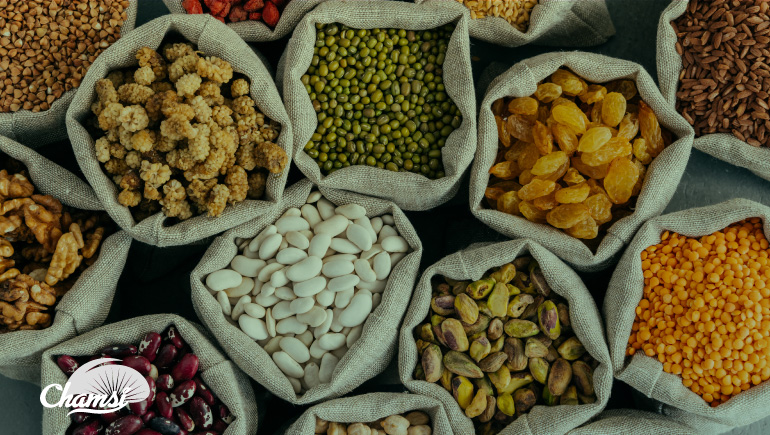Health Benefits and Culinary Approaches to Increase Intake
Much evidence supports the health benefits of consuming a plant-based diet and increasing the intake of legumes. A high intake of fruits, vegetables, whole grains, legumes (beans), nuts, and seeds is linked to significantly lower risks of heart disease, high blood pressure, stroke, and type 2 diabetes (1,2). The American Diabetes Association’s nutrition therapy recommendations for the management of adults with type 2 diabetes note that many eating patterns are acceptable for people with diabetes. Several diets, including the DASH (Dietary Approach to Stop Hypertension) and Mediterranean-style plans, although not strictly vegetarian, still promote increased intake of plant-based foods such as legumes and their associated health benefits (3). Although research supports the benefits of legume consumption, only ∼8% of U.S. adults report eating legumes on any given day (4). The purpose of this article is to highlight the research demonstrating the benefits of increasing legumes in the diet and to offer practical suggestions to aid health care providers in increasing their own legume intake and more confidently discussing such a goal with their patients.
Unlike some other chronic conditions, individuals who have type 2 diabetes are responsible for providing up to 95% of their own care (5). One of the most challenging aspects of type 2 diabetes care is helping patients adopt healthier behaviors. When nutrition therapy is provided by a qualified professional, people can learn how to make better food choices to help improve their glycemic control, blood pressure, cholesterol, and BMI (6). In fact, medical nutrition therapy (MNT), as provided by a registered dietitian, has been shown to improve glycemic control outcomes and reduce health care costs to Medicare (7).
Recent literature demonstrates the benefit of augmenting this nutritional information with a skills-based culinary education. Robust correlations exist between healthy food preparation skills and improved dietary quality (8) and between time spent in the kitchen and mortality (9), supporting the importance of preparing meals oneself. However, a 2007–2008 survey evaluating trends in U.S. home food preparation found a decrease in cooking activities (10). In response, it has been recommended that nutrition counseling expands from a primary focus on nutrients to include developing practical culinary skills (e.g., meal planning, shopping, food storage, and food preparation) (11–13). Culinary education was found to improve attitudes regarding healthy cooking (14) and to increase time spent cooking (15), confidence in cooking (16), healthy food consumption (14,15), and health outcomes (17). One program was reported to improve the pattern of nutrient intake in people with type 2 diabetes (18).
Providers, including physicians, dietitians, nurses, and pharmacists, can provide the knowledge and tools to help build skills and facilitate behavior change, but they can further help their patients (and themselves) in another way: by serving as role models for their patients. Individuals with diabetes who receive counseling from providers who value the importance of a healthful diet—and model this behavior by working to improve their own eating behaviors—are more likely to adopt a healthful eating plan (19,20).
Knowledge, skills, and tools aimed at increasing the consumption of legumes are provided in the following sections and can help health care providers improve both their own and their patients’ eating habits.
Health Benefits of Legumes
By definition, beans are edible, nutritious seeds in the form of pods within the legume family. There are many varieties of legumes (sometimes called “pulses”). Some common types include kidney beans, cannellini beans, Great Northern beans, navy beans, fava beans, cranberry beans, black beans, pinto beans, soybeans, black-eyed peas, chickpeas, and lentils (21).
Many people are surprised to learn just how nutritious legumes are. They provide fiber, protein, carbohydrate, B vitamins, iron, copper, magnesium, manganese, zinc, and phosphorous. Legumes are naturally low in fat, are practically free of saturated fat, and because they are plant foods, they are cholesterol-free as well. One serving of legumes, which is a one-half cup, provides about 115 calories, 20 g of carbohydrate, 7–9 g of fiber, 8 g of protein, and 1 g of fat. Legumes also have a low glycemic index, generally ranging between 10 and 40.
Legumes are an integral part of many healthy eating patterns, including the Mediterranean style of eating, the DASH eating plan, vegetarian and vegan diets, and lower-glycemic-index (GI) diets. Along with being a highly nutritious food, evidence shows that legumes can play an important role in the prevention and management of a number of health conditions.
Type 2 Diabetes
A diet rich in plant-based foods, including legumes, and lower in refined grains, sugar-sweetened beverages, and processed meats has been shown to lower the risk of developing type 2 diabetes and, for those who have diabetes, to improve both glycemic and lipid control (22). In one study, 121 subjects with type 2 diabetes were randomized to either a low-GI diet emphasizing legume consumption (target: 1 cup/day of cooked legumes, or ∼190 g) or a diet emphasizing wheat fiber foods. After 3 months, 93.3% completed the low-GI legume diet arm and reported an average intake of 211 g/day. A similar proportion (95.1%) completed the high–wheat fiber diet arm. Mean A1C fell by 0.5% (P <0.001) with the low-GI legume diet with significant decreases in total cholesterol and triglyceride levels, as well as decreases in systolic and diastolic blood pressure compared to the diet high in wheat fiber foods (23). Other studies have also reinforced the positive effects of legumes on reductions in A1C and blood glucose levels (24,25).
Hyperlipidemia
Regularly eating legumes may help lower total and LDL cholesterol levels. A meta-analysis of 10 randomized, controlled trials in which non-soy legumes were consumed for a minimum of 3 weeks revealed that eating legumes has a cholesterol-lowering effect. The mean net change in total cholesterol in the legume-eaters compared to a control group was –11.8 mg/dL (95% CI −16.1 to −7.5), and the mean net change in LDL cholesterol was –8.0 mg/dL (95% CI −11.4 to −4.6) (26). In another trial, 31 subjects with type 2 diabetes followed either a legume-free therapeutic diet for heart disease or the same diet replacing two servings of red meat with legumes on 3 days/week. Researchers saw improvements with the legume group in LDL cholesterol and triglycerides, as well as in fasting blood glucose and insulin levels (27).
Hypertension
Legumes are rich in potassium, magnesium, and fiber, all nutrients that have a positive impact on blood pressure management (28). A systematic review and meta-analysis combined the results of eight trials involving >500 people, half of whom were overweight or obese, and found reductions in blood pressure in those who ate legumes. In subjects who consumed slightly less than 1 cup of legumes each day for 10 weeks, both systolic and mean arterial blood pressure were significantly decreased (29). In another study, 113 obese subjects consumed two servings of legumes and four servings of whole grains per day for 18 months in place of refined carbohydrate foods. Blood pressure, triglycerides, weight, and waist circumference were reduced (30).
Weight Management
A diet that regularly includes legumes may help with weight control. The fiber, protein, and slowly digested carbohydrate found in legumes may aid in satiety. Using data from the National Health and Nutrition Examination Survey (NHANES), it was observed that adults who consumed a variety of legumes had significantly lower body weights compared with those who did not consume legumes. Legumes consumers also were much less likely to be obese (BMI >30 kg/m2) than non-consumers (31). Furthermore, evidence supports the beneficial effect of a Mediterranean-style eating plan, which is rich in legumes, fiber, and monounsaturated fat, for weight loss (32).
References
https://www.ncbi.nlm.nih.gov/pmc/articles/PMC4608274/



